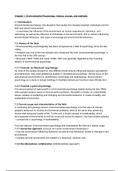Chapter 1: Environmental Psychology: history, scrope, and methods
1.1 Introduction
Environmental psychology= the discipline that studies the interplay between individuals and the
built and natural environment.
→ it examines the influence of the environment on human experiences, behaviour, and
well-being, as well as the influence of individuals on the environment, that is, factors influencing
environmental behaviour, and ways to encourage pro-environmental behaviour
1.2. History of the field
> Environmentally psychologically has been recognised as a field of psychology since the late
1960s.
> Hellpach was one of the first scholars who introduced the term ‘environmental psychology’ in
the first half of the 20th century.
> Brunswik (1903–1955) and Lewin (1890–1947) are generally regarded as the ‘founding
fathers’ of environmental psychology.
1.2.1 Towards ‘architectural’ psychology
As most of the studies focused on how different environments influenced people’s perceptions
and behaviours, they were labelled as studies in ‘architectural psychology. Strong focus on the
built physical environment (i.e. architecture, technology and engineering). Environmental
psychology as a study to design buildings to facilitate behavioural functions was officially born.
1.2.3 Towards a green psychology
The second period of rapid growth in environmental psychology started during the late 1960s
when people became aware of environmental problems. Resulted in studies on sustainability
issues: studies on explaining and changing environmental behaviour to create a healthy and
sustainable environment.
1.3 Current scope and characteristics of the field
A continuing and growing concern of environmental psychology is to find ways to change
people’s behaviour to reverse environmental problems, while at the same time preserving
human well-being and quality of life. To this end, a broad concept of sustainability, which
encompasses environmental as well as social and economic aspects, has been widely adopted.
> evolved into a ’psychology of sustainability’
Four key features of environmental psychology that characterise the field as it stands today:
1.3.1 Interactive approach (a focus on human–environment interactions)
= how the environment influences behaviour as well as how behaviour results in changes in the
environment.
> humans and the environment are related in a reciprocal, dynamic way.
1.3.2 Interdisciplinary collaboration (interdisciplinary approach)
,>closely collaborate with scholars from other disciplines.
> three domains: the disciplines of architecture and geography, disciplines of social and
cognitive psychology, environmental scientists.
1.3.3 Problem-focused approach (an applied focus)
> Trying to contribute toward solving real-life problems.
> Environmental psychology is concerned with problems at all scales, from local to global.
1.3.4 Diversity of methods
> Environmental psychology largely uses the same quantitative and qualitative methods as
other psychological disciplines.
> Environmental psychology is characterised by the use of a wide diversity of methods.
> Choosing a method often involves a trade-off between internal and external validity.
- Internal validity: the extent to which cause-effect relationships can be established. (the
extent to which it can be concluded that an observed effect is caused by an independent
variable).
- External validity: the extent to which the results of a study can be generalised (applied)
to other populations (population validity) or settings (ecological validity).
1.4 Main research methods in EP (NOG EVEN IN HET BOEK CHECKEN, IS ANDERS)
, Chapter 2: environmental risk perception
Crucial question: how people perceive risks. Risk perceptions can prompt or oppose actions to
address particular risks.
2.2
Risk: refers to a situation, event or activity which may lead to uncertain adverse outcomes
affecting something that humans value. The two essential components of risk are the severity
and uncertainty of the adverse outcome (or loss). à involves human evaluation
Environmental risks:
- Characterised by high complexity and uncertainty, entailing intricate causal relationships and
multiple consequences.
- Emerge from the aggregated behaviours of many individuals.
- The consequences of environmental hazards are often temporarily delayed and geographically
distant. à often raise ethical issues (developing countries / future generations (will) suffer from
the people who contribute to the risk)
2.3
Risk perception: refers to people’s subjective judgement about the risk that is associated with
some activity, event or technology. Research has developed several techniques to assess
subjective risk judgements (overall judgement by ranking or rating, willing to pay (WTP), willing
to accept (WTA), estimate the subjective probability of a given outcome).
2.3.1
People often employ heuristics when making judgements, that is, simple, intuitive
rules-of-thumb. Though heuristics often yield valid results, they can also lead to biased risk
assessments.
Bias: judgements are biased if they are systematically distorted in one direction (e.g. away from
a normative standard).
a) Availability heuristic: tendency to base judgements (e.g. concerning the probability of an
event) on the ‘ease’ with which relevant instances of the event can be constructed or retrieved
from memory.
b) Anchoring-and-adjustment heuristic: tendency to bias estimates toward anchors.
Unrealistic optimism (or optimism bias): tendency to believe that oneself will be more likely to
experience positive, and less likely to experience negative, events than similar others.
Unrealistic optimism can have important implications, because individuals may fail to take
preventive actions when they see no personal risk.






